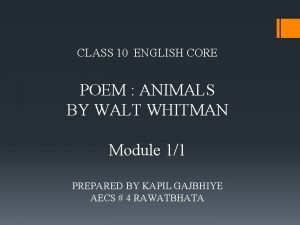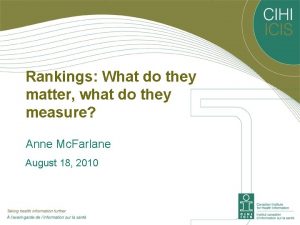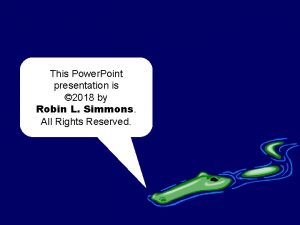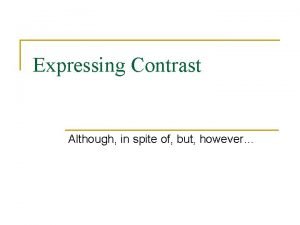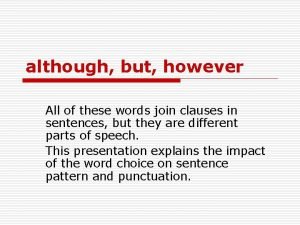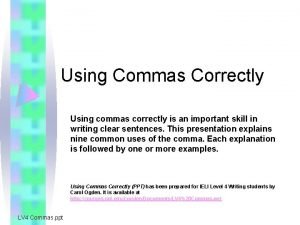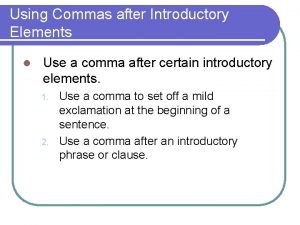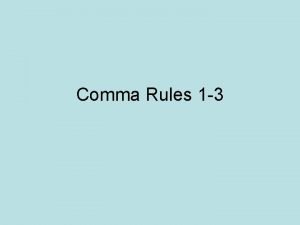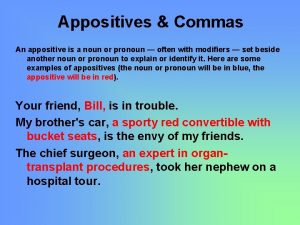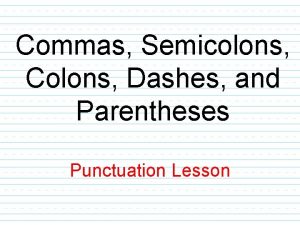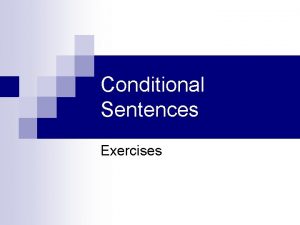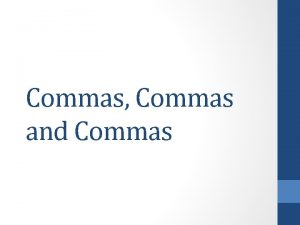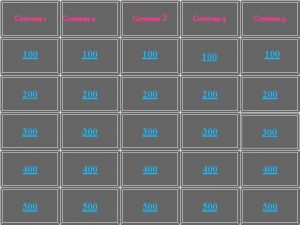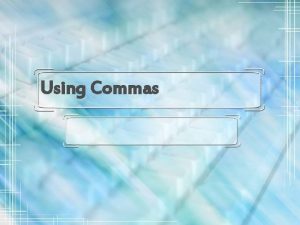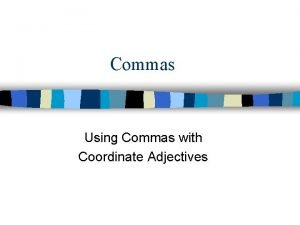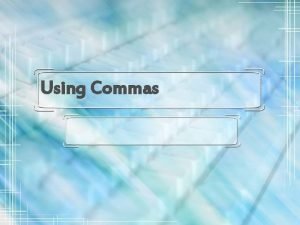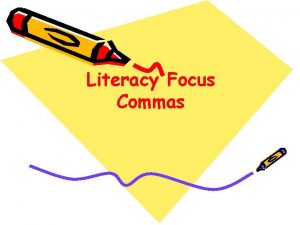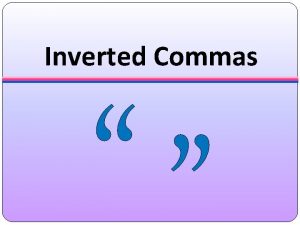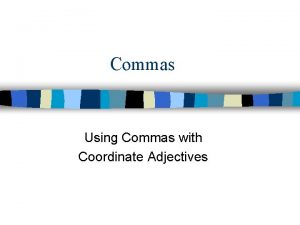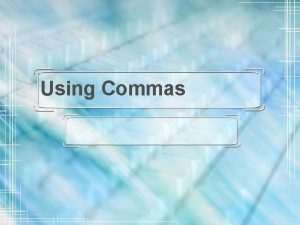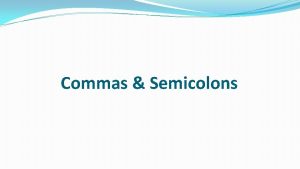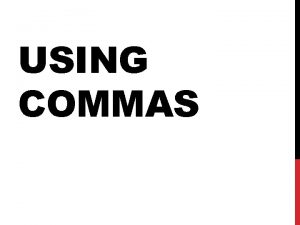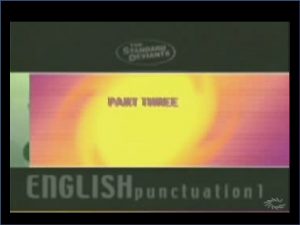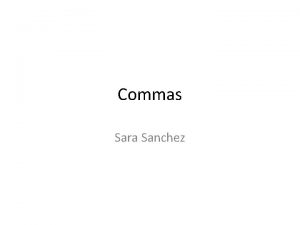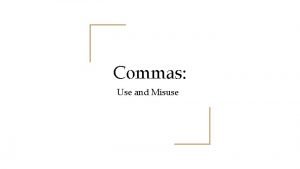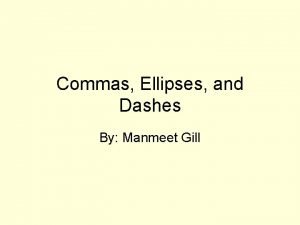Those darn commas Where do they go and


















- Slides: 18

Those darn commas… Where do they go and why

What are the comma rules? l Well, I could tell you the rules, reasons and rationale, but it’s better for you to figure them out yourself, and believe it or not, you do already know them. l I will give you a hint though… the comma rules can be narrowed down into 4 key concepts -2 Ls and 2 Is. Linkers, Listers, Interrupters and Introducers.

Comma Short Hand: While there are many comma rules, often accompanied with complicated terminology, most comma usage can be collapsed into four categories as follows: Linker, Lister Introducer, Interrupter/Inserter.

Lister: Use a comma between items within a list of three or more (not between a list of two). Use the “and” test to ensure that comma is properly placed. (Use this test only for lists. ) Please note: For most writing purposes, the last comma before the “and” is optional (because that comma literally means “and”). Be consistent throughout your paper whichever option you choose. BUT, ACT wants you to include the last comma before the conjunction!!! l I went to the store to buy milk, eggs, cheese, and bread. l I bought a large, black, smelly dump truck.

Linker: Use a comma and a coordinating conjunction—any one of the FANBOYS—to join two independent clauses. One can also join two independent clauses by using the semi-colon (; ) to show a closer relationship of ideas between clauses. Pattern = IC + “, ” + a coordinating conjunction (FANBOYS: for, and, nor, but, or, yet, so) l I stayed up too late studying for the ACT, so I missed my morning chemistry exam. l I stayed up too late studying for the ACT; I missed my morning chemistry exam. l The match ended in a tie everyone agreed that it was too late to play a tiebreaker.

Coordinating Conjunctions official term Connect independent clauses: FANBOYS For But And Or Nor Yet So Time for the “little Timmy” story….

SEMI-COLON LOGIC 1. Use the semi-colon to combine two independent clauses: l John missed the bus; he tried to catch it, but the bus driver appeared to ignore him. l I wanted to come; however, my time was limited. 2. Use the semicolon to separate items in a series where commas are already present within single item descriptors: l Jane went on vacation: to sample exotic cuisine, some of which she found unpalatable; to dance her blues away, as well as unwanted pounds; and to view remote sites, all at high altitudes.

Interrupter/Inserter: Use a comma to set off information that is not essential for a grammatically correct sentence. The interrupter comma resembles the dash (--) and the parentheses ( ). If a complete sentence remains when the information between the two commas is removed, both commas are appropriate; if not, one or both of the commas must be removed. l The game, unfortunately, was rained out. l My mother’s best friend, Mrs. Dobbs, just wrote a best seller. l The skydiver—despite a broken leg—took the medal. l This best selling author (you can learn more about her by consulting my bibliography) now resides in my community.

Appositives - a special “interrupter” l Usually start with one of these articles, surrounded by commas. ¡A ¡An ¡The l Usually add more information and details to the sentence about a person, place, thing or idea.

Introducer: Use a comma after a word, phrase or dependent clause that is inserted in front of a complete thought, an independent clause. If the word, phrase, or dependent clause is added after the independent clause, the need for a comma is usually eliminated. Pattern= Dependent clause (DC) or introductory word + “, ” + Independent Clause (IC): Intro Word: However, I need more time however. Yesterday, I lost my keys yesterday. Intro Phrase: Once upon a time, I believed in fairy tale endings once upon a time. After yesterday’s quiz, I see I need more practice after yesterday’s quiz. In 1993, I was born in 1993. Intro (dependent) Clause: By the time the boy learned to make his bed, he was sixteen. The boy was sixteen by the time he learned to make his bed. When you’re fifteen , and someone tells you he loves you, you believe him. You believe him when someone tells you he loves you and you’re fifteen. Since I’m already late for class, I should grab some breakfast since I’m already late for class. What’s the difference between the two sets of sentences? !

Phrases and Clauses l Definition of the Phrase – a group of words not containing a verb and its subject l Types of Phrases: Appositive, Prepositional, Verbal l Definition of the Clause – a group of words containing a subject and a predicate and used as part of a sentence. l Types of Clauses: 1. Independent or Main (could stand alone as a complete sentence) 2. Subordinate or Dependent (cannot stand alone as a complete sentence) Subordinate clauses come in three types: adjective, adverb, and noun clauses

Some common Subordinating Conjunctions: l As if l If l Although l Before l Because l Since l Though/Even though l Until l Unless l Where/Wherever l When/ Whenever l While l Whether

Some common Subordinating Conjunctions: l Do your sentences start with any of these words? If yes, then you need a comma around this INTRODUCER dependent clause. l Definition: A word that connects a subordinate/dependent clause to an independent clause. l If these “transformer” words start a sentence, then there is a comma before the independent clause that follows it. l If the “transformer” word is in the middle of the sentence, then there is no need for the comma.

Other Comma Rules In addition to previously noted rules, use commas: l between city and state (Flint, Michigan); l between day and year (March 23, 2005); and l within numbers (3, 204. ) l To separate for Dialogue ¡ “Hey, come over here, ” John called to Billy. ¡ “I can’t today, ” replied Billy, “…because I have to do my homework. ” You may also wish to use a comma to emphasize a word at the end of a sentence, as follows: l I want to buy a new car, not a truck. l I want one, too.

Common errors: Comma Splices and Fused sentences l Tomorrow, I want to sleep in but today I had to come to school early. l The ACT is a long, hard, grueling test it is good to practice for it. l Senior skip day is an annual tradition, this year skippers will meet in Kensington Metro Park.

Run-ons Fragments l John went to the movies and Mary met him there. l Until I saw the movie. l Almost everyone who attended. l Done. (artful fragment) l Avoid starting a sentence with “which”, “because”, “like”. These words make the sentence incomplete and dependent.

Now, study real writing… l Find a paragraph in a real book, magazine or article. Notice all the commas and try to determine why the commas or other internal punctuation are there. Which concept fits? l Use these labels to identify and explain why the comma is used at that spot in the sentence: Linker, Lister, Introducer, Interrupter/Inserter (Introducer) (lister) (linker) Example: “Well, I could tell you the rules, reasons, and rationale, but it’s better for you to figure them out (linker) (interrupter) yourself, and believe it or not, you do already know them. ”

Apply this learning … l Now, go into your draft and circle all your commas. l Then, identify why the comma is there (or where it should go) by stating what “rule” it follows = lister, linker, introducer, interrupter. l Add in or delete commas to fix any errors. l Remember what to do to fix comma splices – semi-colon, or comma and coordinating conjunction – FANBOYS.
 Darn cats motivational interviewing
Darn cats motivational interviewing Darn cat motivational interviewing
Darn cat motivational interviewing Darn cat motivational interviewing
Darn cat motivational interviewing Darn cat motivational interviewing
Darn cat motivational interviewing Change talk worksheet
Change talk worksheet The least offensive play in the whole darn world
The least offensive play in the whole darn world Why does the poet wish to live with animals
Why does the poet wish to live with animals Rankings: what are they and do they matter?
Rankings: what are they and do they matter? Commas with and
Commas with and However when to use comma
However when to use comma Use although in a sentence
Use although in a sentence Comma explanation
Comma explanation Commas after introductory phrases
Commas after introductory phrases When to use commas after and
When to use commas after and Commas for appositives
Commas for appositives When to use commas semicolons colons and dashes
When to use commas semicolons colons and dashes If they have time in the weekend they will come to see us
If they have time in the weekend they will come to see us We seek him here we seek him there
We seek him here we seek him there Because you have rejected me i have rejected you
Because you have rejected me i have rejected you






